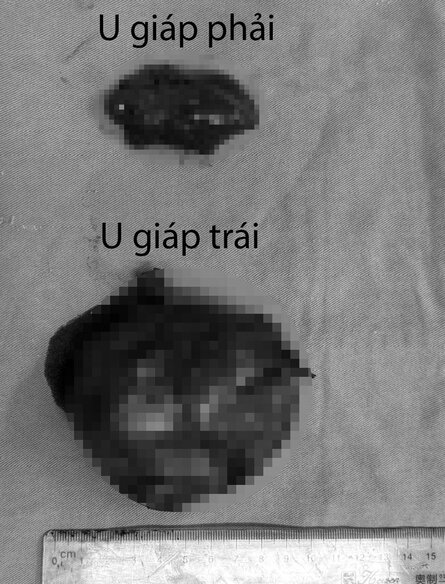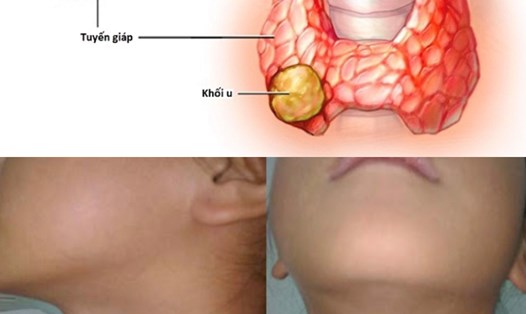Patient N.T.G. (70 years old) was diagnosed with a thyroid tumor before but did not receive treatment because the tumor grew slowly and did not cause pain. However, in the past month or so, the tumor has increased in size rapidly, causing shortness of breath, loss of voice, swallowing and prolonged coughing.
The patient had to be hospitalized for pneumonia due to stagnant phlegm due to narrowing of the air duct. In addition to the above symptoms, the patient's neck area was also clearly deformed due to a large tumor spreading to both sides, causing serious loss of aesthetics and affecting the quality of life.
The CT scan results showed that the tumor in both thyroid lobes was developing abnormally large, especially the left lobes, size up to 7.5 x 6 x 5 x 4.5 cm, spreading deep into the mediastinum, compressing the air duct to the right. The right shoulder also had a tumor measuring 6 x 3 x 2.5 cm, identified as a multiple thyroid butterfly.
The tumor block is seriously compressed, causing the tracheal termic to narrow to only 4mm while the average diameter of the tracheal termic in adults is 1.5 to 2.5cm. Therefore, the patient is always in a state of rapid breathing, shortness of breath and recurrent pneumonia due to poor air circulation.
Before performing surgery, the patient was treated for actively developing pneumonia and preventing edema to stabilize his health. This is a prerequisite to help reduce the risk of anesthesia and surgery.
Dr.BS. Phan Le Thang - Head of the Surgery Department As required, the person directly in charge of the surgery said: With the tumor in the incense cavity deep into the mediastinum, the lower end of the tumor down to the superior arterial and large blood vessels, placing the endotracheal gland is a big challenge due to the airway being compressed, easily constricted and swollen. In the worst case, the team has prepared a plan to open the chest, remove the sternum and provide blood support if there is a lot of blood loss.
After nearly 2 hours, the entire thyroid gland and two large tumors in both lobes were peeled off and safely removed. The pathological results showed that the left affected area was a cyst, the right affected area was a polycystic thyroid gland.

After surgery, the patient was alert, breathing improved well, and did not need ventilator support. Patients can snack, communicate normally and be advised to use long-term hormone replacement to maintain hormonal function.
According to Dr. Phan Le Thang, benign thyroid tumors often develop silently and are easily overlooked if they do not cause symptoms. However, when the tumor is large, it can compress the airways, esophagus and seriously affect the patient's health. Therefore, people should have regular health check-ups, especially thyroid ultrasound, to detect and promptly handle abnormalities. Subjectivity and treatment delays can lead to dangerous complications and make treatment more difficult.











